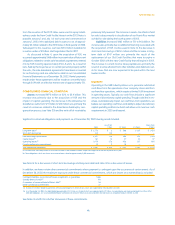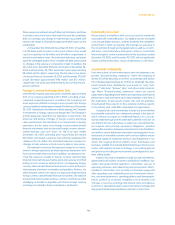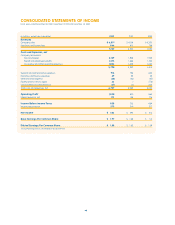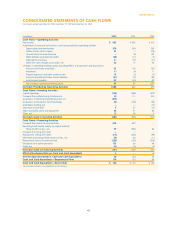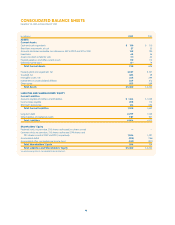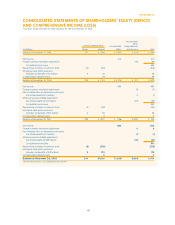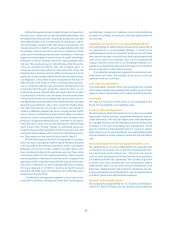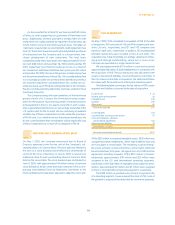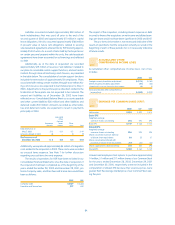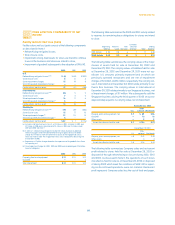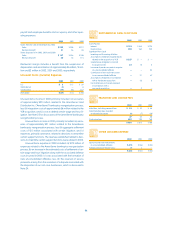Pizza Hut 2002 Annual Report Download - page 50
Download and view the complete annual report
Please find page 50 of the 2002 Pizza Hut annual report below. You can navigate through the pages in the report by either clicking on the pages listed below, or by using the keyword search tool below to find specific information within the annual report.
DESCRIPTION OF BUSINESS
On May 16, 2002, Tricon Global Restaurants, Inc. changed its name
to YUM! Brands, Inc. in order to better reflect our expanding port-
folio of brands. In addition, on the same day, Tricon Restaurants
International changed its name to YUM! Restaurants International.
YUM! Brands, Inc. and Subsidiaries (collectively referred to as
“YUM” or the “Company”) comprises the worldwide operations of
KFC, Pizza Hut, Taco Bell and since May 7, 2002, Long John Silver’s
(“LJS”) and A&W All-American Food Restaurants (“A&W”) (collec-
tively the “Concepts”), which were added when we acquired
Yorkshire Global Restaurants, Inc. (“YGR”). YUM is the world’s
largest quick service restaurant company based on the number
of system units, with nearly 33,000 units in more than 100 coun-
tries and territories of which approximately 36% are located
outside the U.S. YUM was created as an independent, publicly
owned company on October 6, 1997 (the “Spin-off Date”) via a tax-
free distribution by our former parent, PepsiCo, Inc. (“PepsiCo”), of
our Common Stock (the “Distribution” or “Spin-off”) to its share-
holders. References to YUM throughout these Consolidated
Financial Statements are made using the first person notations of
“we,” “us” or “our.”
Through our widely-recognized Concepts, we develop, oper-
ate, franchise and license a system of both traditional and
non-traditional quick service restaurants. Each Concept has pro-
prietary menu items and emphasizes the preparation of food with
high quality ingredients as well as unique recipes and special sea-
sonings to provide appealing, tasty and attractive food at
competitive prices. Our traditional restaurants feature dine-in, car-
ryout and, in some instances, drive-thru or delivery service.
Non-traditional units, which are principally licensed outlets, include
express units and kiosks which have a more limited menu and
operate in non-traditional locations like airports, gasoline service
stations, convenience stores, stadiums, amusement parks and
colleges, where a full-scale traditional outlet would not be practi-
cal or efficient. We are actively pursuing the strategy of
multibranding, where two or more of our Concepts are operated
in a single unit. In addition, we are testing multibranding options
involving one of our Concepts and a restaurant concept not owned
or affiliated with YUM.
SUMMARY OF SIGNIFICANT ACCOUNTING
POLICIES
Our preparation of the accompanying Consolidated Financial
Statements in conformity with accounting principles generally
accepted in the United States of America requires us to make esti-
mates and assumptions that affect reported amounts of assets
and liabilities, disclosure of contingent assets and liabilities at the
NOTE
2
NOTE
1
NOTES TO CONSOLIDATED FINANCIAL STATEMENTS
(tabular amounts in millions, except share data)
date of the financial statements, and the reported amounts of rev-
enues and expenses during the reporting period. Actual results
could differ from the estimates.
Principles of Consolidation and Basis of Preparation
Intercompany accounts and transactions have been eliminated.
Certain investments in businesses that operate our Concepts are
accounted for by the equity method. Generally, we possess 50%
ownership of and 50% voting rights over these affiliates. Our lack
of majority voting rights precludes us from controlling these affili-
ates, and thus we do not consolidate these affiliates. Our share of
the net income or loss of those unconsolidated affiliates is included
in other (income) expense.
We participate in various advertising cooperatives with our
franchisees and licensees. In certain of these cooperatives we pos-
sess majority voting rights, and thus control the cooperatives. We
have previously netted assets of the cooperatives we control with
the related advertising payables. We have shown the assets and
liabilities of these cooperatives on a gross basis in the
Consolidated Balance Sheet for December 28, 2002, and reclas-
sified amounts in the Consolidated Balance Sheet for December
29, 2001 accordingly. As the contributions are designated for
advertising expenditures, any cash held by these cooperatives is
considered restricted and is included in prepaid expenses and
other current assets. Such restricted cash was approximately $44
million and $18 million at December 28, 2002 and December 29,
2001, respectively. Additionally, these cooperatives had receiv-
ables from franchisees of $13 million and $15 million and other
current assets of $3 million and $4 million at December 28, 2002,
and December 29, 2001, respectively, which have been included
in our Consolidated Balance Sheets. As the contributions to these
cooperatives are designated and segregated for advertising,
we act as an agent for the franchisees and licensees with regard
to these contributions. Thus, in accordance with Statement of
Financial Accounting Standards (“SFAS”) No. 45, “Accounting for
Franchise Fee Revenue,” we do not reflect franchisee and licensee
contributions to these cooperatives in our Consolidated Statements
of Income.
Fiscal Year
Our fiscal year ends on the last Saturday in December and, as a
result, a fifty-third week is added every five or six years. Fiscal year
2000 included 53 weeks. The Company’s next fiscal year with 53
weeks will be 2005. The first three quarters of each fiscal year con-
sist of 12 weeks and the fourth quarter consists of 17 weeks in fiscal
years with 53 weeks and 16 weeks in fiscal years with 52 weeks.
Our subsidiaries operate on similar fiscal calendars with period
end dates suited to their businesses. The subsidiaries’ period end
dates are within one week of YUM’s period end date with the
exception of our international businesses, which close one period
or one month earlier to facilitate consolidated reporting.
48.





